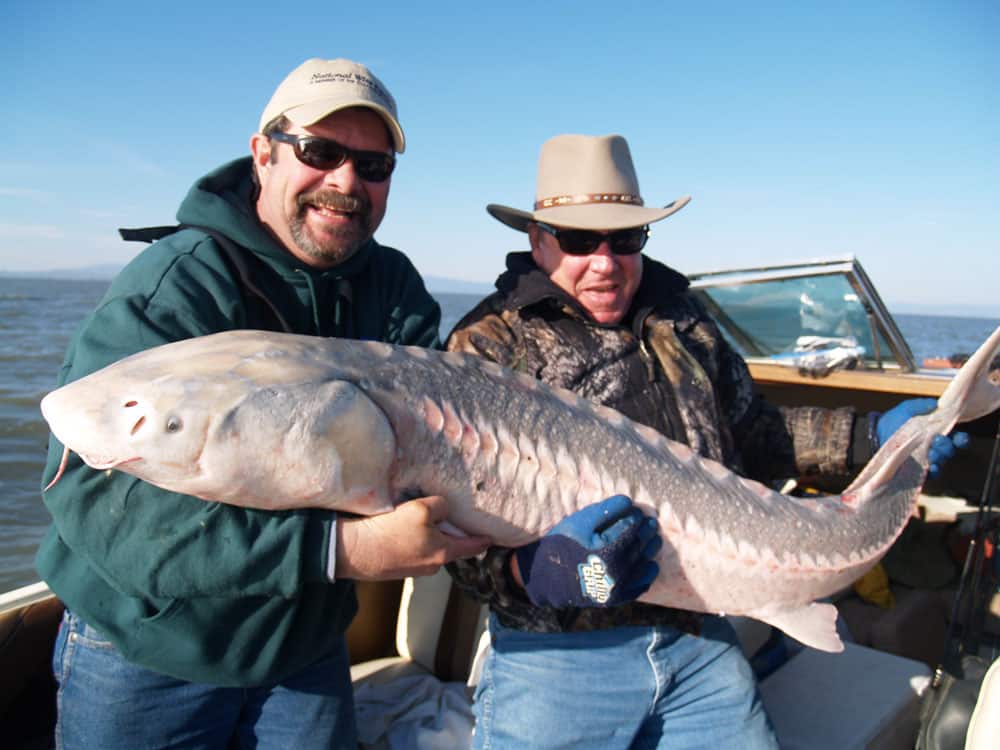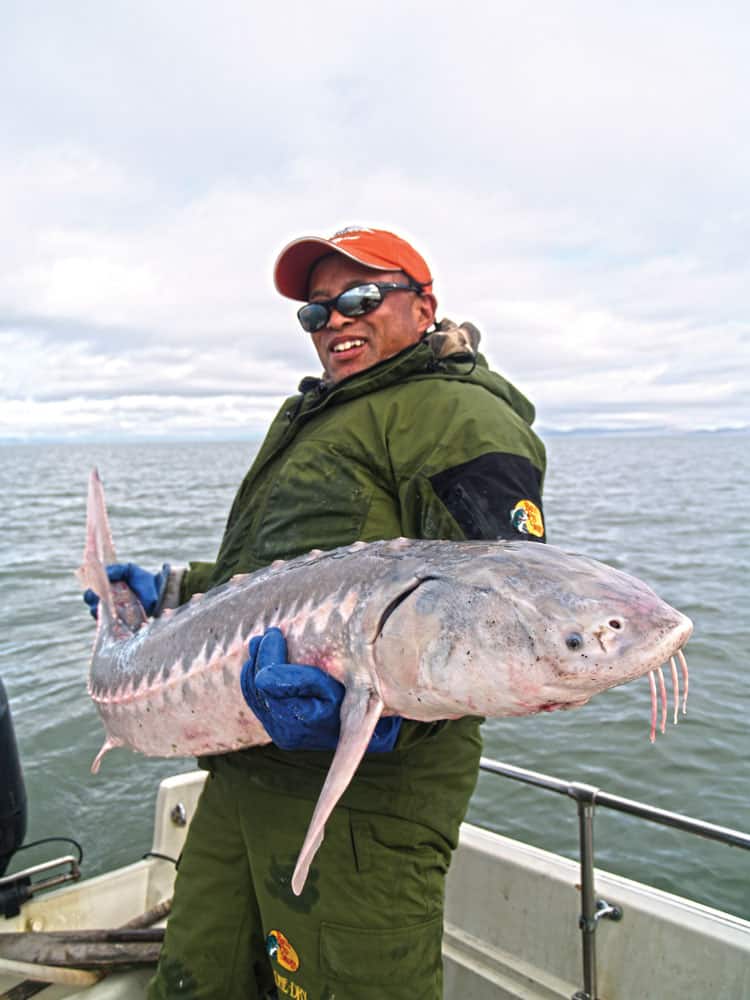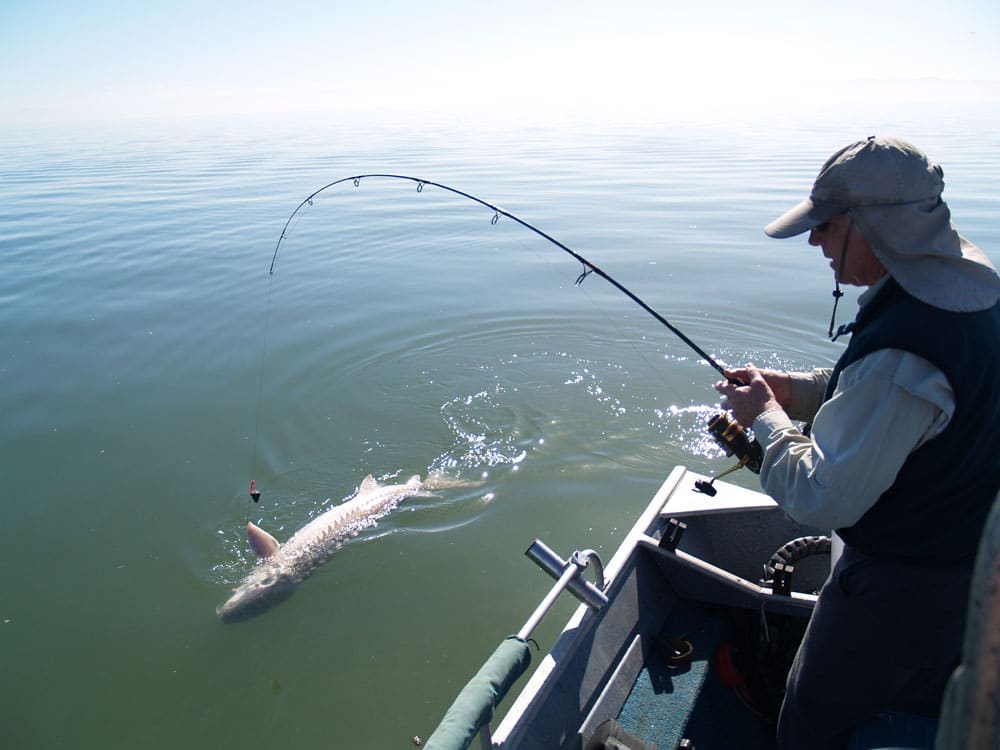The day is sunny, and the shallow expanse of San Pablo Bay is glass calm. The outgoing tide kicks in, and like nesting hens, the four of us guard our rod tips. My brother Angelo and I stand amidships, while our friends Dave Scott and Pat Curran watch the stern lines. I don’t know how much time has elapsed, but without warning, Curran’s rod tip begins to dip.
Curran times the bite perfectly and sets the hook. His spinning rod loads up, and before we know it, a white sturgeon in the 60-pound range dances across the surface. The jump ends with a loud plop, but the moment the fish touches down, it charges down-current on a blistering run. Curran is breathless as he maintains line tension. Eventually the battle ends as Scott makes a deep scoop with the net. Clearing it from the mesh, quick pose shots are taken before Curran releases his finned dinosaur back into the bay.
Hot Spot, Cool Weather
Every year I live for these shallow-water duels, and one of the better places to find them is San Pablo Bay. Forming the northern reaches of our bay system, the San Pablo comprises shallow fertile flats, like open grazing land, and the sturgeon slowly browse across this muddy bottom.
Most of the prime feeding zones for sturgeon vary from 4 to more than 20 feet. It’s open water, and because there is no hard line cutting structure to contend with, it’s the perfect place to play with lighter tackle.
Winter storms, which can take place from late November into May, serve as the main catalyst for triggering the migration of white sturgeon into the San Pablo. The runoff pushes the sturgeon from the delta, where they eventually meander downstream into the bay. Also when the storms coincide with powerful ebb tides, it exposes the bay bottom, thus triggering the sturgeon’s feeding.
White sturgeon travel in foraging groups, and if you happen to hit an active lane, it’s one of the most exciting ways to enjoy the holidays.
Picky Giants
Although they’re built like giant vacuums, white sturgeon are selective feeders, keying in on the predominate food of the area. Top baits for the San Pablo would include grass, ghost and mud shrimp, with the latter being the best. If you want to get bit consistently, use fresh live shrimp when possible. You can also prime the bait by adding a few drops of Pro Cure concentrated sand-shrimp oil.
Target the shell banks. The San Pablo is big, and putting a roving sturgeon into checkmate will take some homework. You can narrow the odds dramatically by anchoring on any number of the shell banks that lie here.
The shell banks hold all types of bottom forage, and like feeding troughs, they in turn attract sturgeon. Some of the primary shell banks are located off China Camp, the Hamilton Flats, and around the Pump House. When you see a shell bank on the depth finder, all you might see is a gradual rise on the bottom and a firm bottom reading. If you drop your anchor on these locations, the anchor will tick briefly before digging in.
Critical Tides
**Incoming tides produce****,****** but by far the strong outgoing tides bring more action on the shallow flats of the San Pablo. Study the tide tables, and when you find a period that predicts incoming tides of 5.0 or better, followed by strong outgoing tides for the late afternoon, it’s time to go. If it coincides with a break after a storm has passed, so much the better.
One of my favorite spots is located off China Camp, on the west side of the bay. The shell bank here covers a lot of property, and depths can vary from 6 to 11 feet during the high tide. When approaching this stretch, I ease in slowly to avoid spooking any fish. A slow approach also gives me time to pick up marks on my fish finder or even see a jumping sturgeon. I don’t know why they jump, but if you see more jumpers or targets on the depth finder, quietly anchor on this general line of movement. It would be smart to mark the location with your GPS because the fish might hold there for a few days. If I don’t see an obvious sign, I’ll anchor where I see a gradual rise coming off the bottom. Sturgeon will feed on these rising beds just as the current kicks in.
Once the anchor line comes tight, fan-cast the baits over a wide area. By doing that, you’ll cover potential feeding lanes as the sturgeon pass by. Also, once your sinker settles in, pick up any slack on the line, allowing for only slight tension on the rod tip.
Small sharks, sculpins, white croakers, and crabs will take your bait, and their unwanted presence will show when the rod tip bounces with sharp taps. Make it a point to check and rebait when necessary.
Generally, the best bite period takes place on the first good push of the outgoing tide, and toward the bottom of the low, as the current begins to slow down. This is evident when swirling current eddies begin to appear on the surface of the water. Stay ready when these subtle changes in the tide develop.
Sturgeon bite softly, and when they show up for a snack, typically the rod tip begins to pump slowly and methodically. When that happens, hit that fish as hard as you can. If you connect, be prepared for some shallow-water fireworks.












